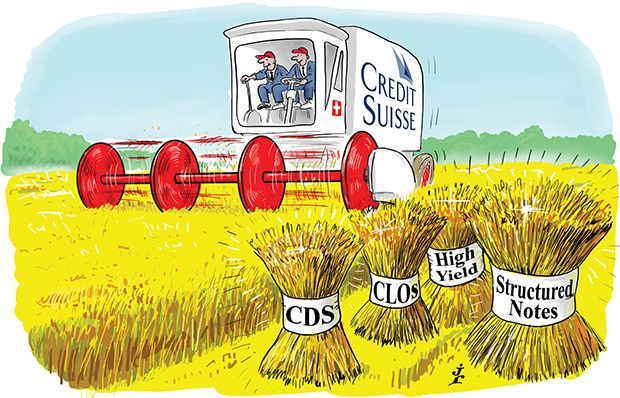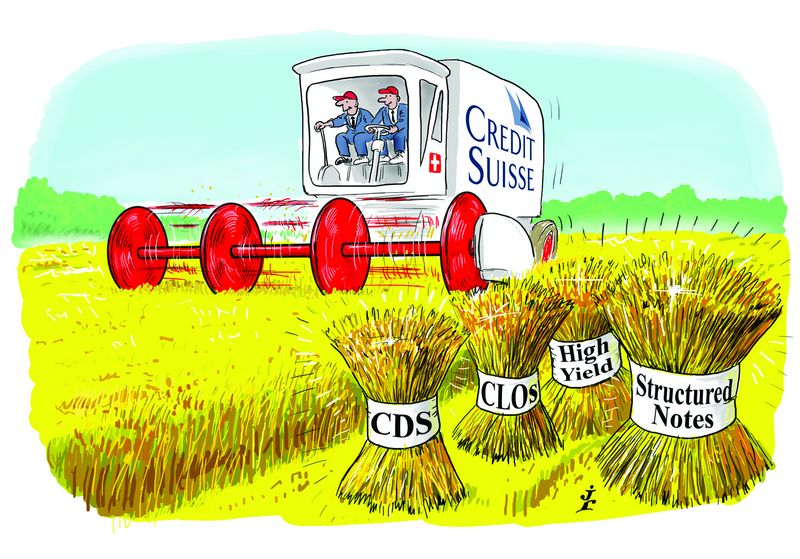In yet another tough year for credit derivatives businesses, as balance-sheet costs soared and banks retrenched, a handful of houses were able to stay the course. For adapting its business to the new regulatory regime while identifying innovative sources of revenue, Credit Suisse is IFR’s Credit Derivatives House of the Year.
The regulatory-induced squeeze on credit derivatives shifted up a gear in 2014, as banks began to grapple with hitting leverage ratio targets in a market where sizeable chunks of business still cannot be cleared through central counterparties.
Couple this with the roll-out of new legal definitions for credit default swap contracts, which aimed to consign the bad CDS headlines of recent years to the history books, and it is hard to argue that it was anything less than a pivotal year for the asset class.
The banks left standing were those that anticipated regulatory change and acted swiftly and decisively to fine-tune their business. It is hard to argue that any firm had to embrace this approach more rigorously than Credit Suisse due to the conservative nature of its home regulator.
But it was not just a case of weathering the storm. CS was one of the only banks actually to grow credit revenues over the first nine months of the year (by 8% in its case).
“I’m proud of the consistency of our returns and our forward-looking approach. Right now we’re harvesting the benefit of the capital-efficient strategy of the last few years, while sowing the seeds for the next step,” said Eraj Shirvani, co-head of global credit products at the bank.
The year’s re-shaping of the business involved the sale of 20% of an illiquid CDS book, which only accounted for 1% of the firm’s volumes, to another dealer.
Shedding this exposure allowed the bank to continue providing liquidity in single-name CDS, even as other European firms were forced to scale back market-making, particularly when the 2014 credit definitions went live in the third quarter.
“We now have a flow business right-sized for the world of the leverage ratio,” said Jonathan Moore, European head of credit trading. “A lot of the competition scaled back in the last 12 months – many dealers were late to this. From 2010 onwards CS has been focusing on the most liquid products.”
Lopping the flab off the edges of its flow business did not affect its market share. On the contrary, CS was at the forefront of the boom in the European high-yield market, which saw single-name CDS spike to average monthly volumes of US$35bn, compared with US$22bn in 2013 and US$16bn in 2012.
The bank believes it holds a dominant position in this segment, capturing a 40% market share, while maintaining a strong position in investment grade trading as well.
Its prowess on the structured side of the business was exemplified by an initiative to provide leverage to middle-market funds involved in lending to European SMEs. These firms fall through the cracks in the current regulatory framework: too small to tap capital markets, but too big for banks to lend to without incurring large capital charges.
Middle-market funds began to crop up to fill the void, effectively printing private CLOs – a market where CS already excels in the public issuance space. As ever, though, securing enough returns on the senior tranche of the capital structure proved a tall order.
This is where CS stepped in: providing leverage through a limited recourse senior secured loan. The bank believes this business is ripe for growth in Europe, given the problems in transferring credit to the real economy.
“It’s a way of optimising liquidity to the real economy in a way that is supportive of our business and in line with the capital framework. We have a spectacular pipeline of business in this area,” said Emmanuel Parrenin, a managing director in credit structuring at CS.
Meanwhile Argentum, the firm’s structured note platform that was launched in January, printed more than US$800m of credit-linked notes through the year, helping the bank climb up the issuer rankings in the process.
“It’s back to the future,” said Shirvani. “It used to be a staple five to 10 years ago – just good vanilla business.”
CS also continues to spearhead industry efforts to manage RWAs associated with the derivatives portfolio, establishing a centre of excellence for capital optimisation.
The headline transaction that resulted was a synthetic securitisation of US$5.3bn of derivatives gap risk exposure to hedge funds and financial counterparties, labelled Project White, which helped its investment bank reduce RWAs at a cost of less than 1.5% per unit.
To see the digital version of the IFR Review of the Year, please click here.
To purchase printed copies or a PDF of this report, please email gloria.balbastro@thomsonreuters.com.



